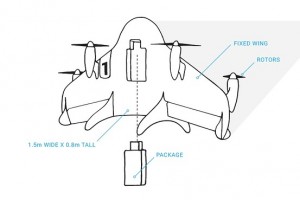
Seamless. Uber. Parcel. Each of these companies seeks to ease the pain of picking up your dinner, hailing a cab, or missing your anticipated package delivery, all while simultaneously facilitating your current Netflix binge. Google now hopes to become part of that list … as if the company didn’t already permeate nearly every aspect of our lives. But, in true innovative fashion, Google aims to take delivery the extra mile and replace the nice college student who delivers your pizza during the summer with airborne drones.
My first thought was of slight reserve, as I don’t know how I would react to C3PO ringing my doorbell. While I do appreciate technology, there are multi-facets to this drone phenomena that have potential to both excite and scare the public. Many national and international organizations share that feeling and despite Google’s goal to advance technology and crush the souls of competition like Amazon, the dark side of these developments are being acknowledged and debated by such organizations.
Last year, Human Rights Watch criticized the use of drones in military bombings. Earlier this summer, the Federal Aviation Administration began debates regarding the television and film industries use of drones on set and whether air rights should be waived. Supreme Court cases have often debated the clash with the Fourth Amendment. These issues demonstrate that drones have the power to affect numerous aspects of the public and legal fields including privacy law, intellectual property, international law boundaries, commercial law, etc. If we thought Google Earth was creepy, drones and like technology can very well take that to a new level.
While the use of drones may not be a surprise to the public, the boundaries they push are. At what point do we regulate? Who do we grant exceptions to? What governing bodies or organizations should be able to decide such? Since technology like drones seems only to be advancing, these are questions the public will require answers to.
Sources: Time Magazine, The WSJ 1, The WSJ 2, Dallas News, Kyllo v. United States, Dow Chemical Co. v. United States.
Photo: The WSJ
Whether we like it or not, drones will become a part of our lives in the future. Most recently, Amazon talked about its futuristic plans to use an “octocopter” drone that will fly packages directly to your doorstep in 30 minutes. In the near future, when drones become more affordable to businesses and individuals, we may expect to have commercial drones buzzing all around us.
I think now may be the best time to put forth plans to regulate drones domestically. I think the Federal Aviation Administration should team up with state governments to document, monitor, and set forth regulations to manage drones so that they can be used by businesses while considering our right to privacy. Drones could be managed in a similar way that automobiles are managed by Department of Motor Vehicles.
I think that exceptions should be given in cases of national security. Drones have played a vital role against the war on terrorism and will continue to do so. However, when it comes to military drones flying around within our borders, I do not think that they should be armed, but should be used exclusively for reasonable surveillance that ensure our safety from any threat.